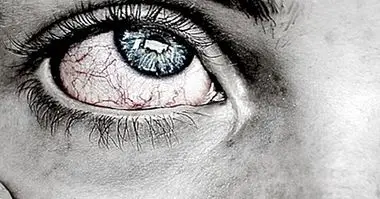Gymnophobia (fear of nudity): causes, symptoms and treatment
The nakedness of the human body has been the subject of ethical and moral debates for centuries . While some people consider it as a natural state of the person, others perceive a naked human body as something ordinary or vulgar, that should not be exposed to the sight of other people.
When this aversion to the perception of a naked person goes beyond the feelings of abhorrence or anger and becomes fear or exaggerated fear, we may be faced with a case of gymnophobia.
- Related article: "The 7 most common specific phobias"
What is gymnophobia?
Gymnophobia, also known as nudofobia, is a specific type of phobia categorized within the classification of anxiety disorders . In the case of this particular phobia, the person experiences a pathological fear of their own and others' nudity.
This fear that is experienced as an exaggerated, persistent and irrational sensation, is presented in those who feel a pathological aversion to the possibility of being seen naked or seeing other people, even within those contexts in which nudity is something natural and acceptable, such as the changing rooms of a gym.
One of the most distinctive characteristics of people with gymnophobia is that, in certain cases, the anxiety response does not appear in a generalized way with all people, but is restricted to a small group of the population.
In the same way, through case studies, it has been possible to confirm that in many of the patients of gymnophobia there is a feeling of inferiority with respect to the body itself , which remains underlying the development of the phobia.
These people tend to compare their body with those that appear in media and publications, in which the ideals or beauty canons are so highly distorted that it included some natural features of the human being are seen as imperfections, leading to the person to experience high levels of anguish and frustration.
This pathological terror to see a naked body, including his own, can cause great interference in the most intimate planes of the person, which can deny to maintain physical or sexual contact, due to the anxiety that causes the idea of having to be naked in front of someone and that someone else is in the same state of nudity.
In the same way, a gymnophobia will avoid encountering situations that involve having to take off your clothes, such as showering in a changing room with more people or even going to certain medical check-ups.
Characteristics of a phobic fear
As mentioned above, gymnophobia is an anxiety disorder, so the fear experienced in it is substantially different from a normative or adaptive fear.
The main characteristics that distinguish a pathological fear from a fear considered normal are:
- Sensation of excessive and disproportionate fear compared to the real threat posed by the situation or the phobic stimulus
- It is irrational, so the person is not able to find a reasonable explanation for their reaction
- It is uncontrollable, so the person is unable to master the sensations experienced
- Generates avoidance and flight behaviors
- Although it only appears before the feared situation, this fear is constant through time and situations
Symptoms of fear of nudity
In spite of the fact that the main symptom of gymnophobia is the experimentation of a great fear before the appearance of the feared stimulus, in this case the nudity, There are many other symptoms of the anxiety reaction that the person experiences .
These symptoms do not have to appear in the same way in all people with gymnophobia. However, these symptoms can be classified into three different categories, depending on whether they correspond to physical, cognitive or behavioral symptoms.
1. Physical symptoms
The first symptoms that the person consciously perceives when facing the phobic stimulus are the physical symptoms. These are due to an overactivity of the nervous system which causes all kinds of changes and alterations in the body:
- Increased heart rate
- Increase in the respiratory rate
- Palpitations
- Feeling short of breath
- Muscular stiffness
- Increased sweating
- Headache
- Gastric changes such as stomach pain and / or diarrhea
- Nausea and / or vomiting
- Feeling dizzy or dizzy
- Fainting and loss of consciousness
2. Cognitive symptoms
The physical symptoms of gymnophobia are always accompanied, in turn, by a series of cognitive symptoms manifested by distorted and irrational thoughts about human nudity.
These ideas are characterized by being irrational and intrusive and, in addition, can be accompanied by mental images of catastrophic content in relation to the possible dangers or threats of the phobic stimulus.
3. Behavioral symptoms
As often happens with specific phobias, the symptoms themselves end up interfering with or conditioning the person's own behavior patterns . These tend to alter the way in which this behaves in daily life, generating two types of responses considered as behavioral symptoms: avoidance behaviors and escape behaviors.
By avoidant behaviors we understand all those behaviors that the person with gymnophobia carries out in order to avoid the dreaded situation or stimulus. For example, avoid entering the changing rooms of a gym.
However, the escape behaviors originate when the subject has not been able to deal with the object of phobia, so he performs all possible acts or behaviors that allow him to escape from the situation as soon as possible.
Causes
At the beginning of the article it was commented that the base of gymnophobia may be related to a feeling of inferiority towards one's body, which has been potentiated or developed into a phobia.
However, there are many other factors that can play a special role when developing a phobia, being the most common experimentation or experiences highly traumatic or with a high emotional content, in which the nudity had a more or less relevant role .
Although it can sometimes be difficult to determine the specific origin of a phobia, there are a number of mechanisms or risk factors that may favor it. These are:
- Genetic elements
- Personality
- Cognitive styles
- Direct conditioning
- Vicarial learning
Treatment
Fortunately, There are a series of very effective treatments that, regardless of the severity in which the phobia occurs , can help reduce the person's symptoms and allow them to lead a normal rhythm and lifestyle.
In the case of gymnophobia, and of any type of specific phobia, the type of intervention that is most successful is cognitive behavioral therapy; in which, in addition to a cognitive restructuring to eliminate distorted thoughts, live exposure or systematic desensitization (DS) techniques are carried out.
In this type of technique, the patient is exposed gradually to situations related to phobia, either directly or through imagination. Along with this, there is a training in relaxation techniques that allow to reduce the level of physical symptoms of anxiety.
Bibliographic references:
- Bourne, Edmund (2005). The Anxiety & Phobia Workbook, 4th ed. New Harbinger Publications.
- Wolpe, Joseph (1958). Psychotherapy by reciprocal inhibition. Stanford University Press.



















